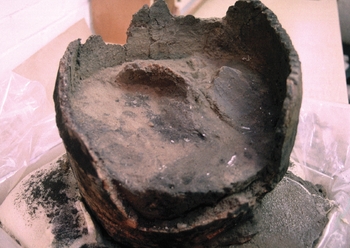Tutt Hill, Westwell, Kent - Integrated Site Report
Oxford Archaeology (South), 2009. (updated 2017) https://doi.org/10.5284/1044816. How to cite using this DOI
Data copyright © High Speed 1 unless otherwise stated
This work is licensed under the ADS Terms of Use and Access.
Primary contact
Stuart
Foreman
Senior Project Manager
Oxford Archaeology (South)
Janus House
Osney Mead
Oxford
OX2 0ES
UK
Tel: 01865 263800
Fax: 01865 793496
Resource identifiers
- ADS Collection: 2460
- DOI:https://doi.org/10.5284/1044816
- How to cite using this DOI
Introduction

As part of an extensive programme of archaeological investigation carried out in advance of the construction of the Channel Tunnel Rail Link (CTRL), Oxford Archaeology (formerly Oxford Archaeological Unit) was commissioned to undertake a watching brief between Westwell Leacon and Tutt Hill in Kent. In the course of the watching brief, a concentration of archaeological features was exposed at Tutt Hill, Westwell, and subjected to detailed excavation. The excavation was carried out between March and August 1999, under the project management of Rail Link Engineering (RLE) on behalf of Union Railways (South) Limited (URS) (a subsidiary of London and Continental Railways).
The small number of features recorded ranged in date from middle Neolithic through to the Saxo-Norman period. These demonstrate a sequence of activity of great length, with a possible hiatus of activity in the early Iron Age and for most of the late Roman and Saxon period.
The earliest activity identified was in the form of pits that belong to ephemeral and temporary occupation in the early and middle Neolithic, followed by a probable period of woodland clearance resulting in the deposition of a layer of colluvium. Four ring ditches, that almost certainly belonged to round barrows, were constructed in the late Neolithic to early Bronze Age (Beaker) period.
During the middle and late Bronze Age the barrows became a focus for secondary burial (cremated remains) and other ritual offerings- some of which can be interpreted as 'closing' deposits, and part of the landscape was divided and reorganised with the laying out of a field system.
After an hiatus in occupation of about 200 years, the site was a focus for industrial activity during the middle to late Iron Age. A furnace and pits containing metalworking debris and crucible fragments were clustered in the far north-west of the site and a single pit deposit indicates either small-scale occupation or hints at associated settlement nearby.
In the late Iron Age to early Roman period a single cremation burial, again in the vicinity of the ring ditches, suggests a reuse of the site for funerary activity and is an indicator that the barrow mounds were still extant. The last activity on a substantial scale took place during the late Iron Age, probably between 50 BC and AD 1, but the site was revisited at least once for the deposition of a cremation burial during the early Roman period.
A pit dated to the early medieval period, represents ancillary activity almost certainly related to the early phases of the manorial complex at Parsonage Farm, to the south-east.
The fieldwork events incorporated in this report are:
- Watching Brief Package 430 (ARC WB430/83+800-84+900) - Watching Brief






